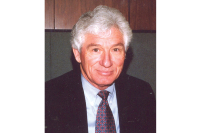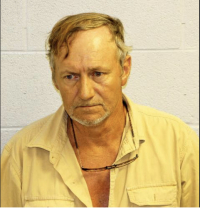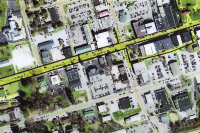Information session on ‘fixing’ N.C. 107 set for next week
Are you ready to rumble? Because here we go again: The great debate in Jackson County on whether traffic congestion along N.C. 107 in Sylva should be fixed, and if so — how — is back.
Since the summer of 2008, the state Department of Transportation has conducted separate traffic studies, each intended to explore different fixes to the same problem.
The preliminary results of one of those studies is about to go public: potential redesigns of N.C. 107, Sylva’s major traffic corridor, which takes in the primary portion of the county that is experiencing business growth. The targeted stretch extends from U.S. 23 Business in Sylva to Western Carolina University.
On Tuesday, Nov. 9, state DOT officials will hold what’s being dubbed an “informal meeting” in Sylva. They intend to publicly layout what they claim must be done if N.C. 107 is truly going to be fixed.
There are six concepts on the table. Three of those concepts would include building an additional road, the controversial Southern Loop, since renamed the friendlier-sounding (and the transportation department claims, more accurate) “N.C. 107 connector.”
Related Items
‘Here it is’
The connector, as originally conceived, would blaze a new road through the mountains. Five miles of construction destroying homes, farmland, and taking in streams and forests — a proposal, that on the face of it, is simply too destructive for serious contemplation by many in the county, including those who stand to lose their homes.
Opponents won a small battle when the transportation department broadened its language describing the N.C. 107 connector as a “multi-lane” freeway to include the possibility of a smaller, two-lane road, at least for the purpose of study.
Jackson County Smart Roads Alliance, the group that acted as the brake on the transportation department’s original plans for a multi-lane bypass, has started revving its engines.
The citizen-action group has pretty much lain dormant for the past few years. But this week it held an organizational meeting at City Lights Bookstore in Sylva. Members are promising to once again bring accountability to the process, and to insist on the inclusion of a wide array of community voices before any decisions are made.
“DOT has forgotten we’re paying attention,” said Jason Kimenker between serving up cups of lightly curried butternut squash soup to his lunch customers at the Soul Infusion Tea House & Bistro, smack dab beside the section of N.C. 107 that is being eyed for improvements. “We have simply been waiting to find out what they were going to do. And, here it is.”
But whether Smart Roads can inspire hundreds of Jackson County residents to participate in what’s often a tedious and mystifyingly complex process — as it once did — remains to be proven. The first test comes next week, at the transportation department’s information session.
Meeting is a response to public pressure
Joel Setzer doesn’t actually have horns and a tail, though to hear some critics of the transportation department, that might come as something of a surprise.
In reality, Setzer is a polite, well-spoken Jackson County native who made good and became the very top dog for the 14th Division of the state Department of Transportation. That means he’s division engineer for a 10-county region that includes Jackson County and encompasses the westernmost tip of North Carolina. Today, Setzer lives on the land he was raised on, commuting a few miles each day from Cullowhee via N.C. 107 to his tidy office — replete with pictures of family members and trout — located in the division’s headquarters near Webster.
“This, in essence, is to help answer the question — ‘Can you fix 107?’” he said of the upcoming meeting.
What happened, Setzer said, is the transportation department really listened. No, really, he said, truly they did.
They heard residents (lots of them, hundreds of them at a time at some points), keep asking whether another road (N.C. 107 connector) was necessary. There were questions about traffic counts, about politics versus need, about desires to build roads positioned against a more environmentally friendlier concept of working in the existing footprint.
That led to the information session (not a public hearing) to share what is known at this point. This, Setzer said, is not required of the transportation department — but the project is controversial, and there have been a lot of questions raised.
The central, nagging question? Whether the transportation department is really doing what the community wants in considering a connector, or by making significant improvements to N.C. 107. Or, are these men and women primed to build roads when a few cars back up on the highway, simply shoving their pet projects down the throats of a reluctant citizenry, all the while egged on by a shadowy yet powerful coalition of would-be developers?
Connecting a network of side roads and linking rural routes to relieve pressure on N.C. 107 is the solution the Smart Roads group advocated when it was active. That option was not included in this study.
What’s on the table?
Here’s what’s being dubbed the six “concepts.” They make only limited sense without accompanying illustrations and maps and explanations from engineers. Those will be forthcoming, Setzer promised, at the information meeting:
• Concept 1 — Traditional widening and intersection upgrades with no N.C. 107 connector, approximately 6.2-miles long.
• Concept 2 — Traditional widening and intersection upgrades with the N.C. 107 connector in place, approximately 6.2 miles long.
• Concept 3 — Superstreet concept (think Cope Creek, along U.S. 23/74, where turnout lanes are now) with access management/non-traditional intersections and no N.C. 107 connector in place, approximately 7.5-miles long.
• Concept 4 — Superstreet concept with access management/non-traditional intersections and with the N.C. 107 connector in place, approximately 7.5-miles long.
• Concept 5 — Non-traditional improvements and other access management strategies in selected locations with no N.C. 107 connector.
• Concept 6 — Non-traditional improvements and other access management strategies in selected locations with the N.C. 107 connector in place.
Right off the bat, it is critical to understand that each of these six concepts were drafted using a “D” level of service: “A” would represent the best operating conditions; “F” the worst. “D” is generally considered acceptable in urban areas, the transportation department noted in a document outlining the concepts for N.C. 107.
Setzer acknowledged that even the level of service used as the baseline in drafting these concepts is arguable. And, surely, will be argued.
One additional, very important point: Setzer said he must know what “the county’s vision” is today. Build, don’t build; improve, don’t improve — “people are going to have to say, ‘What is an acceptable level of service?’” Setzer said.
“There needs to be a community discussion on what it would take to fix 107 … and I don’t think you can proceed without knowing where the duly elected officials stand. We need to know what the vision is. Without that, we’ll simply be spinning our wheels.”
What Smart Roads advocates want
If you want to get involved, it pays to know what you are getting involved in. Jackson County Smart Roads Alliance promotes these alternatives:
• Expand and connect existing roads to accommodate present and future traffic.
• Implement access management concepts and other “traffic calming” solutions for N.C. 107.
• Encourage walkable communities, making it easy for people to get where they need to go without driving.
• Build and expand bike lanes and support the Jackson County Greenway plan.
• Develop public transportation and utilize pre-existing railroad lines.
• Advocate for DOT to use earmarked funds for transportation alternatives.
• Preserve the Tuckasegee River corridor for public use.
Interested? Then learn more at http://wnc.us/smartroads.
Understanding N.C. 107
N.C. 107 is the only major north-south transportation route in Jackson County, and serves as a “collector” for numerous secondary roads, many of which are dead-end roads that have no “connectivity.” It joins Sylva in the north with Cashiers in the south, traveling through Webster, Cullowhee and Tuckasegee in between.
There is dense commercial development along U.S. 23 Business and N.C. 107 between U.S. 23-74 and N.C. 116. About 95 driveways intersect this 3.3-mile roadway segment. Smoky Mountain High School, Fairview Elementary School, Southwestern Community College and Western Carolina University are located along, or near, N.C. 107.
N.C. 107 is a five-lane, curb-and-gutter roadway with narrow 10-foot wide travel lanes from U.S. 23 Business to approximately 1,000 feet south of Fairview Road. From there, N.C. 107 transitions to a four-lane, median-divided facility. Under 2008 conditions, the five-lane section is at, or over, its traffic-carrying capacity during peak traveling hours. By 2035, the entire five-lane section will be operating over capacity.
SOURCE: N.C. Department of Transportation
Get Involved
WHAT: Informational meeting on fixing traffic problems on N.C. 107 in Sylva.
WHERE: Balsam Center (Myers Auditorium lobby), Jackson County campus of Southwestern Community College, 447 College Road in Sylva.
WHEN: Tuesday, Nov. 9, from 5-7 p.m.
WHY: To share six “concepts” that could fix perceived traffic-flow issues.
WHO: Sponsored by the state Department of Transportation.









